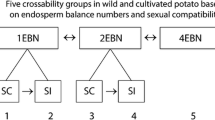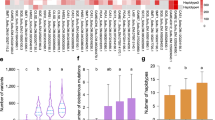Summary
The hypothesis that selection for reduced toxicity occurred as part of the domestication of the potato was investigated by analyses of the total glycoalkaloid (TGA) content of 30 accessions of 8 species of reputed wild progenitors of Solanum tuberosum and S. stenotomum and 12 accessions of 5 species of edible wild potatoes. Although mean TGA content of tubers of likely ancestoral species varied from 24–96 mg/100g, the most likely progenitor (S. sparsipilum) had the highest glycoalkaloid content (range 40–164; mean 96 mg/100 g). Three of the five wild species known to have been eaten historically had potentially toxic TGA content. Mexican S. cardiophyllum and S. ehrenbergii, however, contained almost no glycoalkaloids. The individual glycoalkaloids are reported for each of the accessions studied. The results indicate that the above hypothesis can be accepted.
Similar content being viewed by others
References
Alvarez, G., 1963. Alimentacion del antiguo aborigen del Neuquen. Primer Congreso del Area Araucana Argentina. Tomo II. Provincia del Neuquen y Junta de Estudios Araucanos, Buenos Aires, pp 7–42.
Bailey, F.L., 1940. Navaho foods and cooking methods. Amer. Anthropol. 42: 270–290.
Bye, R.A., 1976. Ethnoecology of the Tarahumara of Chihuahua, Mexico. Ph.D. Dissertation. Harvard University, Cambridge.
Correll, D.S., 1962. The potato and its wild relatives. Texas Research Foundation, Renner, Texas, 606 pp.
Cooper, J.M., 1946. The Araucanians. In: J.H., Stewart (Ed.), Handbook of South American Indians, Vol. 2, Bureau of American Ethnology Bulletin 143, Smithsonian Institution, Washington, pp. 687–766.
Cribb, P.J. & J.G., Hawkes, 1986. Experimental evidence for the origin of Solanum tuberosum subspecies andigena. In: W.D., D'Arcy (Ed.), Solanaceae: Biology and Systematics. Columbia University Press, New York, pp. 383–404.
Cushing, F.H., 1920. Zuni breadstuff. Indian Notes and Monographs 8: 1–673.
De, Candolle, A., 1886. Nouvelles recherches sur le type sauvage de la pomme de terre. Bibliothèque Universelle. Archive des Sciences Physiques et Naturelles. Ser. 3, 15: 425–438.
Galindo, A., J., 1982. La papita guera. Revista Naturaleza (México) 3: 175–180.
Gregory, P., S.L., Sinden, S.F., Osman, W.M., Tingey & D.A., Chessin, 1981. Glycoalkaloids of wild, tuber-bearing Solanum species. J. Agri. Food Chem. 29: 1212–1215.
Gregory, P., 1984. Glycoalkaloid composition of potatoes: diversity and biological implications. Am. Pot. J. 61: 115–122.
Hawkes, J.G., 1978. Biosystematics of the potato. In: P.M., Harris (Ed.), The Potato Crop. Chapman and Hall, London, pp. 15–69.
Hawkes, J.G., 1978. History of the potato. In: P.M., Harris (Ed.), The Potato Crop. Chapman & Hall, London, pp. 1–14.
Hawkes, J.G., 1983. The Diversity of Crop Plants. Harvard University Press, Cambridge, Massachusetts, 184 pp.
Hilger, M.I., 1957. Araucanian child life and its cultural background. Smithsonian Miscellaneous Collections, Vol. 133, Washington, 439 pp.
Jadhav, S.J., R.P., Sharma & D.M., Salunkhe, 1981. Naturally occurring toxic alkaloids in foods. CRC Crit. Rev. Toxicol. 9: 21–104.
Johns, T., 1986. Detoxification fuction of geophagy and the domestication of the potato. J. Chem. Ecol. 12: 635–646.
Johns, T., 1990. With Bitter Herbs They Shall Eat It: Chemical Ecology and the Origins of Human Diet and Medicine. University of Arizona Press, Tucson. In press.
Johns, T., Z., Huamán, C., Ochoa & P.E., Schmiediche, 1987. Relationships among wild, weed, and cultivated potatoes in the Solanum x ajunhuiri complex. Syst. Bot. 12: 541–552.
Johns, T. & S.L., Keen, 1985. Determinants of taste perception and classification among the Aymara of Bolivia. Ecol. Food Nutr. 16: 253–271.
Johns, T. & S.L., Keen, 1986. Taste evaluation of potato glycoalkaloids by the Aymara: a case study in human chemical ecology. Hum. Ecol. 14: 437–452.
Johns, T. & I., Kubo, 1988. A survey of traditional methods employed for the detoxification of plant foods. J. Ethnobiol. 8: 81–129.
Johns, T. & S.F., Osman, 1986. Glycoalkaloids of Solanum Series Megistacrolobum and related potato cultigens. Biochem. Syst. Ecol. 14: 651–655.
Latcham, R.E., 1904. Ethnology of the Araucanos. J. Anthropol. Inst. 34: 170–180.
Laufer, B., 1938. The American plant migration: Part I: The potato. Field Mus. Nat. Hist. Anthropol. Ser. 28: 1–132.
Mamani, M., 1981. El chuño: preparation, uso almacenamiento. In: H., Lechtman & A.M., Soldi (Eds), La Technologia en el Mundo Andino. Vol. 1. Universidad Nacional Autonoma de Mexico, Mexico, pp. 235–246.
Osman, S.F., S.F., Herb, T.J., Fitzpatrick and P., Schmiediche, 1978. Glycoalkaloid composition of wild and cultivated tuberbearing Solanum species of potential value in potato breeding programs. J. Agri. Food Chem. 26: 1246–1248.
Palmer, E., 1871. Food products of the North American Indians. U.S. Commissioner of Agriculture. Report of the Year 1870, pp. 404–428.
Pennington, C.W., 1963. The Tarahumar of Mexico. University of Utah Press, Salt Lake City, 267 pp.
Pennington, C.W., 1969. The Tepehuan of Chihuahua. University of Utah Press, Salt Lake City, 413 pp.
Sanford, L.L. & S.L., Sinden, 1972. Inheritance of potato glycoalkaloids. Am. Pot. J. 49: 209–217.
Sinden, S.L., L.L., Sanford & R.E., Webb, 1984. Genetic and environmental control of potato glycoalkaloids. Am. Pot. J. 61: 141–156.
Ugent, D., 1970. The potato. Science 170: 1161–1166.
Ugent, D., T., Dillehay & C., Ramirez, 1987. Potato remains from a Late Pleistocene settlement in Southcentral Chile. Econ. Bot. 41: 17–27.
White, L.A., 1945. Notes on the ethnobotany of the Keres. Mich. Acad. Sci., Arts, Letter, Papers 30: 557–568.
Whiting, A.F., 1939. Ethnobotany of the Hopi. Museum Northern Arizona, Bulletin 15: 1–120.
Woolfe, J., 1987. The potato in the human diet. Cambridge University Press, Cambridge, 231 pp.
Author information
Authors and Affiliations
Rights and permissions
About this article
Cite this article
Johns, T., Alonso, J.G. Glycoalkaloid change during the domestication of the potato, Solanum Section Petota . Euphytica 50, 203–210 (1990). https://doi.org/10.1007/BF00023646
Received:
Accepted:
Issue Date:
DOI: https://doi.org/10.1007/BF00023646




